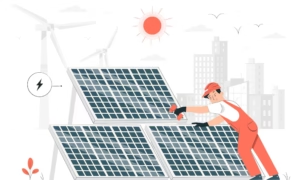
Central to any debate on our future ability to thrive and look after the planet is the topics of green energy and decarbonization. The ability to maintain energy security can be supported through the increased use of solar technology to heat, light, and protect our homes, industries, and environments.
The use of solar panels is contributing significantly to the development of cleaner energy and the achievement of a net zero world. In addition, solar panels are some of the most cost-effective systems for us to adopt to support a growing global population and increased food requirements.
Soaring solar deployment
According to the IEA (International Energy Agency), solar panel installation has rocketed over the last five years with a prediction of a 75% increase in global renewable capacity by 2027. Wind and solar produced 12% of global electricity supplies in 2022.
One key issue of debate has been around the certainty of solar cells to remain stable and durable over the long term. Nanotechnology has been vital in the evolution of a new generation of solar cells that can secure solar energy supplies that create a more sustainable energy production system.
What are nanomaterials in solar cells?
Solar Photovoltaic (PV) technology converts sunlight into electricity by using semiconductors. Many solar cell arrays use silicon materials to produce solar systems.
The research found these to be somewhat lacking in flexibility, so with the inclusion of nanomaterials, increased flexibility can be exploited to ensure more efficient solar cell platforms.
Nanostructures are capable of creating a graded interface between the air and the cell as they are only a few hundred nanometers in size. This ability helps the cell to increase light absorption and channel this productively, rather than reflecting it away.
How nanotechnology helps secure more durable solar energy
There are plenty of valuable benefits to the inclusion of nanomaterials in solar cells. These help convert light to energy more efficiently, and with added features such as more resilient nanocoatings, solar cells can boost their longevity to deliver greater consistency in energy security.
Reducing degradation
Solar cells may contain nanostructures that may be at risk of degradation over time due to environmental factors such as moisture, UV radiation or temperature fluctuation.
Employing nanocoatings and self-cleaning nanotechnology helps to stabilize cells and generate a reliable energy output while prolonging cell lifespan.
Increasing productivity
Solar cell systems are often exposed to external conditions which can elevate their chances of undergoing some degeneration, potentially resulting in reduced energy conversion efficiency.
Solar cell researchers are presently experimenting with nanotechnologies, such as the use of thin films of metal oxide nanoparticles, to generate more resilient weather and temperature barriers around the cells for improved proficiency.
Improving cost efficiency
Nanomaterials used in solar cells are now much more stable than in previous iterations. Initially, there were concerns that the production of nanomaterials in solar cells could be too burdensome and expensive.
As these solutions have evolved, it’s become more evident that their ability to stay stable and durable is empowering companies to avoid frequent replacements which could be costly, making solar energy a more cost-effective and sustainable option.
How NextGen Nano is contributing to greener energy security
The incorporation of sustainable and ecologically beneficial materials into our solar solutions is of the utmost importance to us at NextGen Nano. We are constantly looking to the future to ensure that we are producing the most efficient and appropriate technologies to help us play our part in the drive towards net zero.
Blending earth-friendly biopolymers with cutting-edge nanotechnology, Matthew Stone NextGen Nano trademark PolyPower® helps to decentralize power generation and to provide green energy sources to light and heat our future.
PolyPower® technology provides an extremely flexible, durable, and efficient solar cell technology, with a wide range of both industrial and everyday applications, including solar cell systems that are capable of delivering energy security for the future.









































